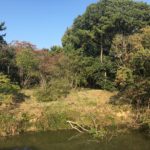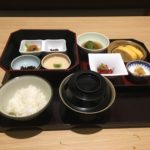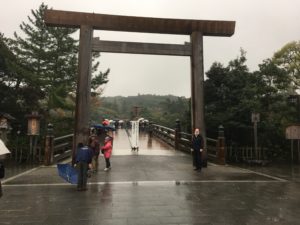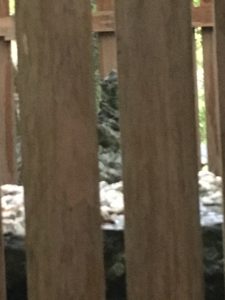Saturday night’s dinner in the hotel was lovely, if rather expensive. Sunday I spent the whole day creating the presentation I am to give in Tokyo on Friday. The paper was written over the summer, and sent to my host in early October to be translated into Japanese, but the presentation – which has to be 30minutes long – needed a day’s work and I simply hadn’t had time in the past month to get round to it. By the end of the afternoon, though, I was happy. An afternoon nap was unavoidable, and the thought of venturing out into the city thereafter far too daunting, so I settled for another expensive dinner in the hotel.
******
Monday 7th Nov
Awake at 3 AM I eventually got up showered and went down to the lobby to pay my bill and was first to sit down for breakfast at 6:30 AM. The Marriot do a very good breakfast. This meant I also had the joy of joining the rush hour commute on my two train journey from Shin-Osaka via Tennoji to Mozu. This is a densely packed, sprawling, intense city. The Osaka prefecture, including all the various districts, tops 8 million; I am finding it a little claustrophobic.

At Mozu, in Sakai district, however, lies the open space and tranquil beauty of Emperor Nintoku’s mausoleum : probably the largest burial mound in the world, with its cluster of thirteen smaller surrogate mounds, in the great Daisen park surrounding it. From Mozu station I walked anti-clockwise the whole way around the enormous main kofun – keyhole shaped and surrounded by moats – arriving at last, nearly back where I started, at the only real entrance to the site, the Worship Gate.

But this place is not for tourists. Indeed there isn’t even all that much in the way of signage, and what there is is muted and respectful; there’s certainly no Interpretation Centre, just a tiny information office with leaflets. The Japanese, it seems, are not so willing to commercialise their ancient dead as some other cultures. The place is meticulously cared for by an army of gardeners, but for its own sake, not for our eyes.

At the entrance, I carefully lifted the bamboo ladle in my right hand, poured water over the back and front of my left, transferred the ladle and likewise washed my right hand, transferred again and poured a little water into the palm of my left hand, replacing the ladle cup-down where I had found it, to rinse my mouth with the cool water in the palm of my left hand, while the quiet trickling into the little pool before me seemed for a moment to be the only sound. Shaking the drops from my hands, I then bowed twice towards the great mausoleum, and gently clapped my hands twice. Proper respect shown, I stood back, took some photos, and wandered off into the park behind me towards the Richu-tenno-ryu – the 2nd largest kofun here, largest of the surrogates of the Nintoku-tenno-ryu kofun.

In a little rest area, there were some sleepy cats among the benches, in the park, and i sat quietly with one to type up this little account of my visit.
*************
So, from Nintoku-tenno-ryu kofun I took four trains: back via Tennoji to Shin-Osaka, to buy another Bento box, and to the Marriott to get my bags, and then onto the Shinkansen – the famed bullet train (which really does travel faster than any train I’ve ever been on) to Nagoya, and onto a more local train from there down to Ise. It was wonderful to see countryside. Although most of the flat alluvial land has buildings, or a patchwork of fields and buildings, the hills are steep sided and covered in trees, rising like dark green sharp-topped ridges out of the plain. At times the train snaked between them and the landscape almost felt wild….
[P.S. One thing I have noticed since my arrival – an astonishing number of people wear face masks. In a carriage of about 40, on the local train, I counted 7 : 6 women of all ages, one man in his 40s. I have seen many more men – of all ages – with them, elsewhere. I’m not really sure what to think of this; it certainly doesn’t inspire confidence.]
***********

In Ise, right outside the station and pretty easy to find, is the Ise Shinsen : a hotel with a difference! Everything is included in the price of the room. Guests are encouraged to wear one of the range of Japanese robes (yakuta) provided in racks in the lobby – all individually wrapped in plastic fresh from the laundry. Each room has a very spacious balcony with high slatted bamboo walls, sporting a private outdoor onsen: the hot tub for which Japan is rightly famed, accessed not just from the sliding glass doors of one’s room but through the two-door shower room where the little seat and bowl of the traditional onsen washing area enable one to prepare oneself appropriately for the hot-tub experience.

After onsen, at the set time one has agreed at the desk, one descends to the restaurant for a full kaiseki: the multi-course Japanese dinner that is an essential part of experiencing Japanese culture. Mine was at 8pm, given that I had only arrived in Ise at gone 5pm, and I confess I was a little late. Sitting on the sofa in my room after onsen, I dozed off. But at 8.06pm the phone in the room went off and it was reception reminding me my dinner was ready! Clearly timing is very important for many of the dishes. To say that every mouthful was both exotic and exquisite is only half the story. As something of a foodie who rather loves a good dinner, I have to say it was one of the finest dinners I have ever had. The only thing that would have improved it would have been company: fine dining alone is never quite such fun as with one’s loved ones.
Managing to sit for only about 10mins on the sofa in my room, digesting, I got to bed at 10pm feeling very happy to be out of the city, in a small town clustered around its famous ancient shrines, immersed in traditional Japanese culture.
********
Tuesday 8th November.

Today – awaking as late as 6.30am – was my day at the Ise Jingu – the Shrines of Ise. There are some 125 in total, none exactly called the Ise Shrine/Jingu, but all, collectively known as the Ise Jingu. The outer shrine is called Geku, the inner shrine, some few kilometres (a 430Y bus ride) away, is called Naiku. I had managed to arrange a volunteer guide, who met me at the Ise Tourist Office, who took me round both Geku and (on the bus to, and around) Naiku and explained, in his halting but clear English, where we were, how to behave, what to do, and what it was all about.

In contrast to the warm sunshine that greeted my long walk around Nintoku’s Tomb and the Daisen park yesterday, today’s weather in Ise was wet. Very wet. By the end of the day, my Berghaus jacket was almost wet through, and my walking trousers likewise. But, as my cheerful guide explained, on fine days one can barely walk through the crowds at Ise Jingu, and today we were blessed with thin crowds, and only the briefest of waits at each shrine. Better still, the great stones lining the steps up to the Main Shrine at Naiku only show their dark green lustre when wet. So, all in all, a rainy day for Ise is not so bad after all. The Geku shrines all have odd numbers of round trunks on top, and the pointed roofs have horizontal ends. The Naiku shrines all have even numbers of round trunks on the top, and their pointed roofs have vertical ends. Black and white stones mark out the precincts, and, my guide tells me, he thinks some of the dualism of Chinese religion infected Shinto many centuries ago – Taoism, as I said, and he agreed.

Shinto is the old religion of Japan. It is, if one were to classify it, an ‘animist’ religion. Stones, trees, mountains, Emperors, are regarded as inhabited by kami – spirits of objects and of places. The kami are, if you like, the consciousness of inanimate matter: in some senses the topic of some of the papers at the conference I am speaking at here in Tokyo. The kami themselves are familiar to anyone who has played Pokemon Go – the Pokemon are modelled on them, as is the very concept that such virtual creatures might appear (in the camera viewport of one’s smartphone) in special locations. Like ancient European dryads in trees, dwarves in the earth, faeries among the meadows. But the Japanese – and Shinto itself in many respects – are very much in favour of co-existence. So Buddhism is popular here, too, and mixtures between the two; more recently, capitalism has become very popular in Japan, of course, alongside Shinto and Buddhism, so the syncretism between Shinto and capitalism observable in Pokemon is no surprise. The world could learn a thing or two from the Japanese.

Preparation for a visit to a Shinto shrine involves washing: it is important not to take dirt into sacred space. There is a pool of water within a wall about two feet high, with a rack of bamboo ladles face down upon the rack, and a moat-like channel at one’s feet around the pool. The ritual is fivefold: picking up the ladle from the rack with one’s right hand, you scoop up some clear water and then, over the channel at one’s feet (1) pour it over the left hand (2) transfer the ladle to the left and pour it over the right hand (3) transfer back to the right and pour some into the cupped palm of the left, (4) take a sip from one’s palm but let the water drop down into the channel around the pool “never drink the water!” and then (5) hold the ladle upright so the rest of the water runs down to clean the handle of the ladle, so it is clean when you replace it, cup-down, on the rack. I had read about this, and managed to do it (more or less) at Nintoku yesterday, but was glad of the fresh instruction from my guide.

The Torii, or classic gate through which one then enters a Shinto Shrine, was, of old, made of simple, unpainted wood. Nowadays one sees many painted Torii, some that are even made of concrete! At Ise they remain classic, unpainted wood. They are the markers of the boundary between ordinary and sacred space. At Geku, today, I felt it. Great shrines such as this one have two such Torii, as if the area between them were some kind of purgatory, a place of transit: indeed there is a building here, between the outer and inner Torii, where the priests undertake their cleansing. Taking off one’s hat and bowing lightly before crossing the boundary, one acknowledges the transit between the worlds.

Inside I felt the strength of the past fourteen hundred years of continous worship in this place. It was a privilege and an honour, made all the stronger for the clear reverence felt by my guide for these shrines and their sanctuary, and the clarity of his descriptions and instructions. We visited five of the many shrines at Geku, and four at Naiku. Approaching the shrine, one first makes an offering – usually a 10yen piece, placed in the offertory (although the main shrines, because they are visited by the Emperor himself, have only a cloth, and no offertory as such). Then one bows deeply, twice. Then one claps one’s hands twice, the right hand slightly lower than the left, so that the fingertips of the righthand clap against the second pads down of the left hand: this makes the proper sound. Then one puts one’s hands together (neither lower than the other) to utter a silent inner prayer. After the prayer one lets one’s hands fall to one’s sides, and gives a final low bow.
Each shrine is inhabited by a kami. Each kami has two aspects – a calm and benevolent one, and an aggressive one. So there are often two shrines to the same kami, but each to a different aspect. To some kami (especially the main shrine at Geku) it is appropriate only to make a silent prayer for the good of others: world peace, feeding the poor, and such. To some kami, a private prayer, for oneself, or for loved ones, is more appropriate.

The shrines themselves are wooden, and thatched. Every 20 years – in Geku according to reliable records since 690 CE – the shrines are rebuilt, exactly the same as before. This refreshes buildings made of very short-lived material (the thatch especially) and keeps the skills needed to undertake such work continually in practice, from generation to generation. The buildings are thought to be modelled on the form of the original rice stores, from about 2000 years ago when rice began to be grown in Japan. So each shrine has two courtyards: one where the wooden shrines are and people pray; and a second immediately next to it that is empty. The empty space has the same central area covered in white (sacred) stones, surrounded by an area covered in black (clean) stones, but no buildings. Once the twenty years is up, a new set of buildings will be built, in the empty sanctuary, and when they are complete in elaborate ceremonies the stone or wooden home of the kami will be transferred across to its new buildings, and dressed in new apparel, with new furnishings, etc. Briefly, there will be two shrines, one next to the other. At Geku this will next happen in 2033, and my guide recommends I return then, (albeit that I’ll be 70 years old!) to see this. Then the old shrines are dismantled. The main pillars of the Main Shrines are then used to make Torii at both Geku and Naiku, and the old Torii go off to make Torii at other shrines around the country. When those Torii are retired their 60 year life as shrine wood comes to an end and they are sliced up into little tablets: good luck charms, one of which my Guide gave me to take home with me: very precious. At this point I remembered I had been advised to bring my guide a gift from home, and produced the small photo frame from the Lowry Gallery in Salford as my present to him from home. He was as delighted as I was with my tablet of sacred wood that had stood once, for twenty years, as the main pillar of Geku Main Shrine at Ise.
Visiting a shrine is not altogether dissimilar to visiting a Cathedral, in that there is a formal approach, a set of actions (kneeling, lighting a candle) that accompany a prayer, and, importantly, a part of the sacred building that is reserved, in Churches, for the Priests – at the High Altar – and in Shinto shrines like Ise, for the Emperor and his family. The difference here is that at the Ise Main Shrines the reserved area is most of the shrine. The public get to worship at the outer fence, tossing their coins upon the cloth. There are four fences, and if you are dressed in a very formal black suit or white dress (and, I think, pay the appropriate fee) you can be escorted by a priest in traditional costume beyond that fence to worship at the third fence. Beyond that is off limits.

My experience of Geku was, in some ways, more moving than that at Naiku. Perhaps Naiku felt less sacred because the rain was heavier and I was already very wet and starting to get very tired. But at Naiku we visited what I would probably say was the single highlight of the whole visit: the shrine of Takimatsuri-no-Kami – God of the Offerings to the Rapids, as I understand it, or ‘A kami that protects the Isuzugawa River is enshrined here,’ as the map tells it.

This is a very small place, a little fence around a very small precinct of black and then white pebbles. There is no wooden shrine at all: just one, single, small and roughly shaped standing stone, in the midst of the little white sacred pebbles, surrounded by the obligatory wooden fence beyond which one cannot step. According to my guide, it is believed that this is oldest – the original – shrine of Ise. It is as if long, long ago a wise Japanese sage told a story about the consciousness of all matter, and pointed to this stone as an example: “even this stone is conscious of itself, and of all other stones, in its stoneness;” from this, perhaps, grew the idea of kami – anthropomorphising the stone-consciousness yet still limiting it to a particular theme. Each kami has a theme, be it soil, water, or some other aspect of the world. This stone was so old, its theme was merely being the oldest, guarding the river where pilgrims used to wash, the original shrine of Ise, small, unassuming, mostly ignored by the pilgrims gathered around the great Main Shrine with its huge pillars and golden round trunks on the top. It meant a lot, and I was especially reverent worshipping in the prescribed manner at this shrine. Here, it seemed, for me, in my European way, filled with all my experiences of standing stones throughout Europe, was something I could really connect with: a kami in a standing stone.
Dripping wet, after getting some traditional rice cakes and a traditional good luck charm at the souvenir shops, (no ancient dead here, after all) and the bus back to my hotel, I was VERY glad of the onsen in my hotel room, and delighted in the soak at the end of this amazing day, before yet another, delicious, incredible, kaiseki dinner.
